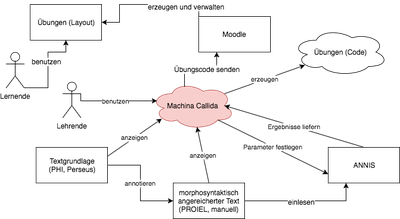Web App vs. Desktop
How should the Machina Callida be designed? As a specialized service or as a comprehensive application? As a web app or mobile app or desktop application?
(K. Schulz)
Regarding the Outcomes of the Workshop we noticed that the planned solution will not work. So there has to be a new way of designing the software:
On the one hand, the overview emphasizes the central and diverse role of the Machina Callida, which, in view of the common definition of "service" as a negative foil, rather speaks in favour of a comprehensive software application: "A service is a self-describing and self-contained modular application designed to execute a well-delimited task, and that can be described, published, located, and invoked over a network" (Jureta et al. 2009, 66). The aspects "well-delimited" and "invoked over a network" are particularly important here. The former is questioned by the multi-layered user perspective alone, since teachers are supposed to use the software in a completely different way than learners. The latter becomes particularly difficult when large amounts of data (e.g. raw text or annotated corpora) are to be made available for public education. Our project experience has shown that we cannot always rely on external resources, but must also integrate our own services.
So now that it is clear that we are dealing with larger software, the question of its architecture arises. Two recent developments in software development give cause for thought here. Firstly, with regard to Rich Internet Applications, we can no longer simply insist on browser limitations to justify a decision in favour of desktop applications: "The trend is towards providing a richer set of functionality, to close the gap of interactivity and usability between Internet applications and their desktop counterparts" (Farrell & Nezlek 2007, 417). The keywords of functionality and user-friendly interaction are of direct relevance to CALLIDUS. So if Web Apps are hardly inferior to desktop applications in these aspects, or even no longer inferior, what could be the decisive factor in the necessary decision for one of the two concepts?
This is where the second development comes into play, which, although not fundamentally new, has become increasingly important in recent years: "Indeed, one of the important features of popular Web applications is to support user participation to add value to the application and collaborate with other users" (Jazayeri 2007, 211). This is not to say that users cannot also collaborate in other forms of application and help shape and expand content independently. However, there is a tendency for this aspect to be particularly prominent in many web apps. This, in turn, is not insignificant for our project because both teachers and learners are constantly generating new content: new corpora, new annotations, new exercises, new evaluation data and feedback. Only by combining these different ways of participation can a comprehensive user experience be made profitable.
❮ back forward❯
Bibliography
- Farrell, J., & Nezlek, G. S. (2007). Rich internet applications the next stage of application development. In Information Technology Interfaces, 2007. ITI 2007. 29th International Conference on (S. 413–418). IEEE. Abgerufen von http://citeseerx.ist.psu.edu/viewdoc/download?doi=10.1.1.463.4588&rep=rep1&type=pdf
- Jazayeri, M. (2007). Some trends in web application development. In 2007 Future of Software Engineering (S. 199–213). IEEE Computer Society. Abgerufen von http://delivery.acm.org/10.1145/1260000/1254719/28290199.pdf?ip=194.94.11.44&id=1254719&acc=ACTIVE%20SERVICE&key=2BA2C432AB83DA15%2E4741FB345F76967E%2E4D4702B0C3E38B35 %2E4D4702B0C3E38B35&CFID=829641895&CFTOKEN=59958688&__acm__=1510737656_83f256c783ca6bc2e0ee724198105ac1
- Jureta, I. J., Herssens, C., & Faulkner, S. (2009). A comprehensive quality model for service-oriented systems. Software Quality Journal, 17(1), 65–98. Abgerufen von https://link.springer.com/content/pdf/10.1007%2Fs11219-008-9059-2.pdf

